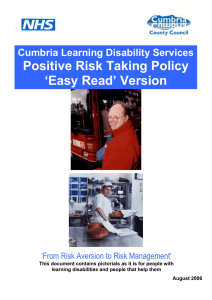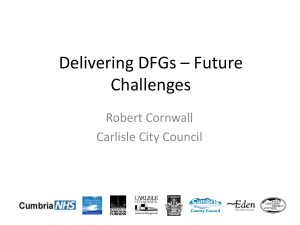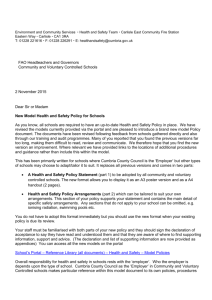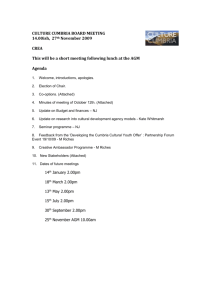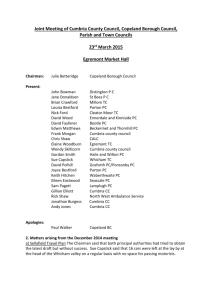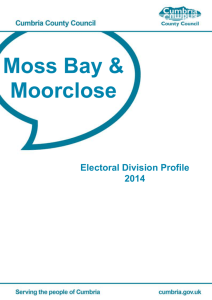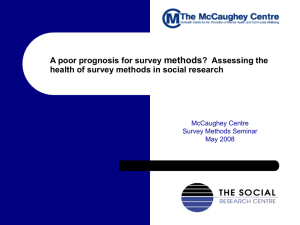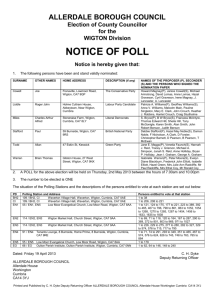109. Ipsos MORI Technical Note on Surveys
advertisement
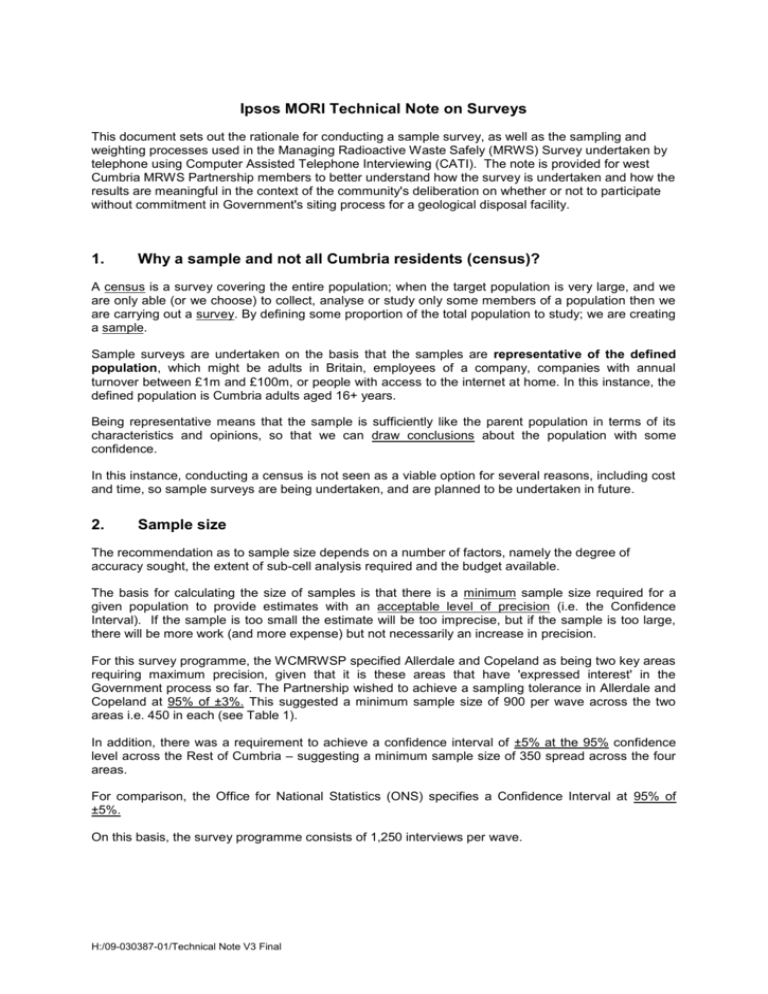
Ipsos MORI Technical Note on Surveys This document sets out the rationale for conducting a sample survey, as well as the sampling and weighting processes used in the Managing Radioactive Waste Safely (MRWS) Survey undertaken by telephone using Computer Assisted Telephone Interviewing (CATI). The note is provided for west Cumbria MRWS Partnership members to better understand how the survey is undertaken and how the results are meaningful in the context of the community's deliberation on whether or not to participate without commitment in Government's siting process for a geological disposal facility. 1. Why a sample and not all Cumbria residents (census)? A census is a survey covering the entire population; when the target population is very large, and we are only able (or we choose) to collect, analyse or study only some members of a population then we are carrying out a survey. By defining some proportion of the total population to study; we are creating a sample. Sample surveys are undertaken on the basis that the samples are representative of the defined population, which might be adults in Britain, employees of a company, companies with annual turnover between £1m and £100m, or people with access to the internet at home. In this instance, the defined population is Cumbria adults aged 16+ years. Being representative means that the sample is sufficiently like the parent population in terms of its characteristics and opinions, so that we can draw conclusions about the population with some confidence. In this instance, conducting a census is not seen as a viable option for several reasons, including cost and time, so sample surveys are being undertaken, and are planned to be undertaken in future. 2. Sample size The recommendation as to sample size depends on a number of factors, namely the degree of accuracy sought, the extent of sub-cell analysis required and the budget available. The basis for calculating the size of samples is that there is a minimum sample size required for a given population to provide estimates with an acceptable level of precision (i.e. the Confidence Interval). If the sample is too small the estimate will be too imprecise, but if the sample is too large, there will be more work (and more expense) but not necessarily an increase in precision. For this survey programme, the WCMRWSP specified Allerdale and Copeland as being two key areas requiring maximum precision, given that it is these areas that have 'expressed interest' in the Government process so far. The Partnership wished to achieve a sampling tolerance in Allerdale and Copeland at 95% of ±3%. This suggested a minimum sample size of 900 per wave across the two areas i.e. 450 in each (see Table 1). In addition, there was a requirement to achieve a confidence interval of ±5% at the 95% confidence level across the Rest of Cumbria – suggesting a minimum sample size of 350 spread across the four areas. For comparison, the Office for National Statistics (ONS) specifies a Confidence Interval at 95% of ±5%. On this basis, the survey programme consists of 1,250 interviews per wave. H:/09-030387-01/Technical Note V3 Final 3. Defining the sample and setting the quotas A sample is defined from the population under consideration, and its properties should match those of the total population. For this survey programme, the sample was designed to be representative of the population in terms of age, gender and working status. Based on the 2008 up-dates of the 2001 Census, quotas for each of these variables were set within Allerdale, Copeland, and the remaining four districts i.e. the Rest of Cumbria. 4. Sample generation As more than half of UK telephone numbers are ex-directory or registered with the Telephone Preference Service (TPS), a representative sample must include these numbers (n.b. TPS exclusions do not apply to market research). Consequently, we used a random digit dialling (RDD) sampling method to ensure that all telephone numbers relevant to each district in Cumbria area are included in the sample. In the U.K. each customer receives a telephone number composed of three groups of digits: the first group is the town/city code e.g. 0151; the second group an area code e.g. 227 and the third group is the subscriber e.g. 5181. The customer group can contain up to 9999 possible numbers. In RDD surveys, every telephone number in each area may be obtained randomly from a few ‘seed’ numbers from which other numbers can be generated by adding or subtracting 1, 2, 3, 4, 5, 6, 7, 8, 9, 10 etc. RDD has the advantage that it includes unlisted numbers that would be missed if the numbers were selected from a telephone directory. It does not, however, account for those households that take their telephone numbers with them when they move. Consequently, we include a screener question at the start of the survey to confirm in which district area the respondent resides, and include only landlines. RDD samples are drawn from the U.K. telephone subscriber database which contains all non-exdirectory listings for BT, Cable & Wireless and many cable company subscribers, and is updated daily. In this case, the database was stratified via postcode data to cover each of the local authority areas in Cumbria, and a sample of telephone numbers in each location was selected from this; the last two digits of these ‘seed’ numbers were randomised by computer to produce a representative sample. Typically, we obtain a sample of telephone numbers 30 times the number of interviews we wish to achieve i.e. some 38,000 RDD numbers for each wave of the survey. 5. Weighting and balancing the data The results are weighted at the analysis stage to be fully representative of the population of Cumbria (via 2008 mid-year Census estimates) in terms of age within gender and working status. Based on home location, we also assign respondents to their district and ensure that responses from districts are balanced (i.e. included in the weighting frame) to ensure the overall results reflect the actual population distribution. Weighting is the process by which data are adjusted to reflect the known adult population profile. This is to counter any effects of differential refusal rates, or to correct for any over-sampling. A 'weight' is the percent assigned to a particular demographic descriptor. The sample needs to be weighted if the responses show that particular groups (for example those living in a particular area) are under or over represented in the sample. If this is not carried out then the results will not reflect properly the views of the adult population being considered. However, a sample which is weighted is less accurate (i.e. has a larger standard error) than an unweighted sample of the same size. The effect of this weighting, therefore, needs to be taken into account when considering statistical reliability, and this has been accounted for when analysing the data sets for this survey programme. H:/09-030387-01/Technical Note V3 Final
